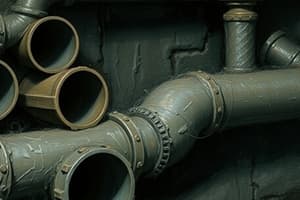Podcast
Questions and Answers
What is the purpose of a Sanitary Drain?
What is the purpose of a Sanitary Drain?
- Receives acidic industrial waste
- Receives stormwater only
- Receives discharges of both sanitary and storm water
- Receives domestic waste only (correct)
A Combined Drain permits the discharges of both sanitary waste and storm water.
A Combined Drain permits the discharges of both sanitary waste and storm water.
True (A)
Match the following house drain appliances with their description:
Match the following house drain appliances with their description:
House Trap = Device installed in the house drain to prevent gases from public sewer circulating through plumbing system Area Drain = Assembly with a running trap to protect basement floor from freezing Floor Drain = Receptacle for receiving water from the floor into the plumbing system Yard Catch Basin = Receptacle for catching surface water drained from yards, driveways, and courts Garage Catch Basin = Device to convey wastes from garage, wash rack, grease pits, and repair floors
What is the function of a Back Flow Valve?
What is the function of a Back Flow Valve?
The ____________ is sometimes referred to as the Collection Line of a Plumbing System.
The ____________ is sometimes referred to as the Collection Line of a Plumbing System.
Flashcards are hidden until you start studying
Study Notes
House Drain
- The House Drain is a part of the plumbing system that receives discharges from soil and waste stacks within a building and conveys them to the House Sewer.
- It is also known as the Collection Line of a Plumbing System.
- The House Drain can be installed underground, suspended below the floor, or inside the ceiling.
Types of House Drains
- Sanitary Drain: receives only sanitary and domestic waste, and conveys it to a public sewer or septic tank; storm water is not allowed in the sanitary drain.
- Storm Drain: conveys only storm clear water or surface water waste, and terminates into lakes, rivers, dry runs, or natural basins.
- Combined Drain: receives both sanitary waste and storm water; this type of drain is no longer permitted.
- Industrial Drain: receives discharges from industrial equipment containing acid wastes, and terminates into a separate drainage basin.
Size of House Drain
- The size of the House Drain depends on its service, whether it's for sanitary waste or storm drain.
- For sanitary waste, the Fixture Unit load discharge is the basis of computation.
- For storm drain, the roof area that accumulates the major rainfall waste is the basis for determining the pipe size.
Grade or Slope of House Drain
- A minimum slope of 2% is recommended for the House Drain.
- In some cases, a slope of less than 2% may be adapted, but it should not be less than 1%.
- A slope greater than 2% increases the velocity and discharge capacity of the pipe, but may cause decreased water depth and negative pressure.
Change of House Drain Direction
- Changes in direction should be done with long radius fittings; short tees, 1/4 bends, and short turn L fittings are not permitted.
- Soil branch should be run at a right angle to the main.
- Fixture connections should run at a right angle to the branch.
House Drain Cleanout
- The House Drain should be provided with adequate cleanouts to prevent breaking of the floor in case of drain stoppage.
- Cleanouts should be located where they are readily accessible, and should be equipped with a threaded screw cover.
- Any branch of the House Drain terminating at a floor drain or fixture should be provided with a 100 mm diameter pipe, extended at least 2 inches above the floor, inserted in a 45-degree Y branch in the direction of the drain flow.
House Drain Appliances
- House Trap: a device installed in the House Drain to prevent gases from the public sewer or septic tank from circulating through the plumbing system.
- Back Flow Valve: a device used in a drainage system to prevent the reversal of flow; it is installed in a House Drain or branches of the House Drain that are subjected to reversal flow of liquid.
- Area Drain: a device used to receive water to be drained from the basement floor, and is equipped with a cleanout.
- Floor Drain: a receptacle used to receive water to be drained from the floor into the plumbing system; it is usually installed on the basement floor, near heating equipment, below the kitchen sink, and in the vicinity of the laundry.
- Yard Catch Basin: a receptacle used to catch surface water drained from cemented courts, driveways, and yards.
- Garage Catch Basin: a device used to convey wastes from garage, wash rack, grease pits, and repair floors into the House Drain; it includes drain tile receptor, sewage ejector, automatic water siphon, sump pit, and grease basin.
Studying That Suits You
Use AI to generate personalized quizzes and flashcards to suit your learning preferences.




